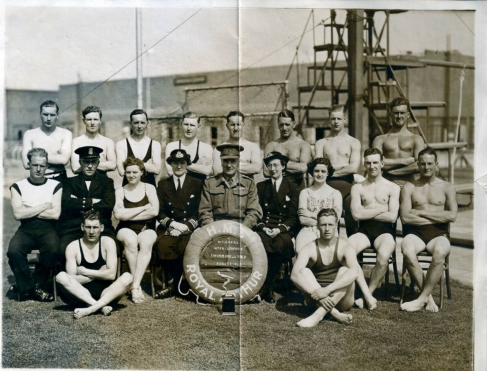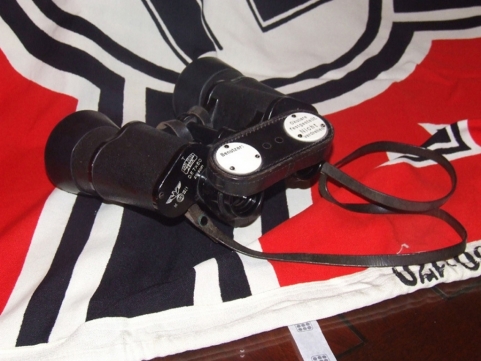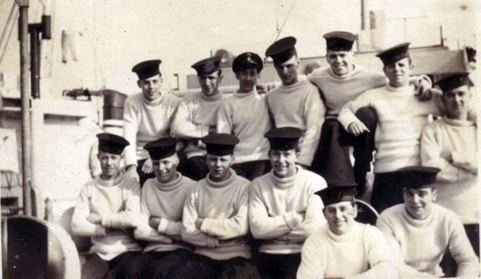Here are some emails received in response from interest shown and requests for information about the Coastal Forces. Although not shown replies have been sent! Emails below are from:-
Click on link to view emails. In June 2012 I was sent a couple of emails from Elizabeth about the ship's bell of HMML 345.
Dear Chris
I have finally managed a picture of the bell. The writing is not totally clear; but I could not get it any better, even though I tried various lights, and flash. The smaller writing underneath is my name - Elizabeth Anne Priestley, and the date of the baptism 1st April 1945 (no comments please, about it being All Fool's Day!) Apparently it was fairly usual for children to be baptised on board ship, with the bell used upside down as the font. I believe that I behaved well; but my brother, about 21 months at the time, was found to be a bit tiddly, as he had been finishing up the dregs of various pink gins!
By the way, the bell is about 7 inches (18 centimetres) tall and the same across at its widest.
I hope you will come and visit me in prison if the Admiralty gets wind of this theft!
We came across some interesting photos of my father's naval career in an album at my sister's. This shows that my Dad skippered the ship from its first launch. I haven't time to send you anything from it at the moment, but will try before too long.
Best wishes from Elizabeth
Below are a couple of emails from Julian Foynes I had in June 2012. Julian has published books about the Coastal Forces, "Google" his name for further information.
Dear Sir
Your website about Roderick Timms RNVR is of considerable interest to me, and rang some bells in my head.
Some years ago I published a history of the 1939-45 East Coast (mainly naval) war in which the MLs, Brightlingsea, the Finnish barque ALASTOR and Yarmouth feature prominently. "R Timms RNVR" is also a name I had heard of, as I'll explain later.
I can shed a little light on some of the photos showing ML 345 and her crew in spring 1942. The ML was built, as you say, at Isleworth (which happens to be where I live).
From there ML 345 would have gone to Brightlingsea for 3-4 weeks to be inspected, fit out and "work up". The "Captain ML" who came on board and gave a talk was Captain J P Farquharson RN, who was in charge of all the Coastal Forces (ML, MGB, MTB) fitting and commissioning from the Thames to the Humber. In the 1980s I interviewed one of his officers and I also used to know his RN Writer-Secretary.
Two of the your ML 345 photos were of especial interest to me--the ones with 2 or 3 men on/ near(?) a jetty, with two craft up on slips, and what appear to be two buildings with low rooves shaped like inverted Vs in the background. The scene is almost certainly Aldous Successors' Shipyard at Brightlingsea, where Farquaharson's personnel did the ML-equipping and where other MLs were built and/or repaired. There was a large double iron hangar there, back from the water and jetties, with such roofs. It still exists.
I have a personal connection with it as both my parents, my grandfather, and an uncle all worked there during the war, though not for Farquharson. The "Dockyard Lists" for Brightlingsea, which I copied at the old RN Historical Branch years ago, say that ML 345 arrived at B'sea on 4 April 1942. I don't know if you confirm that that is the locality.
As a further point of interest, in one of these two photos one of the slipped craft has French tricolor flag on her masthead. That must be ML 125, alias SAINT RONAN, which was also refitted at Aldous' in April-May 1942.
ALASTOR (in other photos) was used as a store and secondary base ship by army patrol boats, and later by the flotillas of small training landing craft stationed in Brightlingsea Creek and Burnham-on-Crouch, which is about 15 miles south-west. When doing trials, Farquharson's MLs used the Blackwater entrance, which is where ALASTOR was moored.
I've now found the Timms reference I mentioned at the start. In my copy of Sir Peter Scott's "Battle of the Narrow Seas" Sub-Lt RJ W Timms RNVR is standing on a boat's bridge alongside Lt Sykes. I don't know if you've seen this photo.
Yours faithfully Julian Foynes
Dear Chris
Good to hear from you. It's an odd thought that I've had my copy of Scott's book since boyhood--I knew the photos by heart and therefore recognised Roderick Timms on your website right away.
Yes, do quote me as you like. I must just correct the number of the French ML: St RONAN was 123, not 125. I have been working on another book (just on North East Essex 1939-45) and if it does see the light of day would like to use one of the two Brightlingsea photos I mentioned, with citation and reference to your website.
I noticed your reference to Toughs' Yard, Teddington. It built the first A, B and D Type MLs, and was also the starting point for many of the Dunkirk "little ships". Years back I visited it, interviewed Mr Tough, and copied some of his MTB and ML photos--a most helpful man. I would imagine that ML 345 went up to Teddington to finish off. Coincidentally the various components of each ML were loaded up onto lorries or trains and distributed to the different building yards from Brentford Dock, which is just downstream from Isleworth. I have a set of photocopied standing orders which Farquharson (B'sea Captain ML) got his secretary to draft in 1941, as regards arrangements for manning, equipping, trialing and supplying the MLs. If any more of your father's photos show the East Coast, I'd be interested to see them. You have a first-rate collection there.
One thing always intrigues me: the wartime ban of private photos of naval bases and airfields---yet I've seen many! Farquharson was a tartar who would have put your Dad on a charge for taking a camera to the shipyard, but the actual Naval Officer in Charge of NEMO (Brightlingsea base, as opposed to Coastal Forces equipping) was very relaxed. The chief Wren on the base at the time, 3rd Officer Dowding, told me that she preferred Farquharson to the NOIC. She, incidentally, was the wife of Commander Dowding RNR, who was killed a few months later while commodore of the Arctic convoy PQ17.
By another zany coincidence, my parents were employed on the MLs in the big hangars in the background of your 2 photos, and married the very month they were taken (April 1942) local registry office, no honeymoon, back to work on the warships next day!
Yours Julian
The emails below were received in the last half of June 2012 from Bernard "Bunny" Lacome.
Chris, I have just finished reading, for the second time, the Internet tribute to your precious father Rod Timms. I knew him and many of the other officers mentioned.
I was radar officer at HMS Beehive during 1944-1945. I came on board in January and I believe Rod joined two or three months later. We shared meals and drinks together in the officers' mess at the Little Ships Hotel – played darts and shove-ha’penny now and again. Rod and the other seagoing officers used to invite us "backroom boys" on board an MTB for elevenses, a crucial quick drink before lunch. A pennant (I can't now remember the colour) flew from the mast of the boat that was host of the day.
After the Germans surrendered I was posted to India as Port Radar Officer in Bombay. While I was out there I met "Yockers" and Balkwill in Colombo, Ceylon. They, together with other Beehive officers, sailed a flotilla of motor launches to the Far East. Took them a month to get there.
I chuckled when I read about your father's leather jacket. I thought you would like to know that in some mysterious way I became the owner of a pair of European-size 44 hand-cobbled sea boots – fitted me "like a glove" and probably came from the same wardrobe as the jacket.
I'll be ninety next birthday. My children, grandchildren, and great-grandchildren want to hear stories about my time as a sailor – also about my life and career both before and after the war. Among other things, I shall make sure they have the link so they can read about Roderick James Weston "Rod" Timms who rose from Ordinarily Signalman to Lieutenant Commander and who was a friend of mine during the war.
I live in Toronto, Canada, now: Lt. (L) RCN, Retd. I wish you and your family and loved ones all the very best. Bernard "Bunny" Lacome
Hi Chris,
Glad to receive your cheery reply messages. Glad also to know you are hands-on familiar with the Gin Pennant. That was always an attractive magnet. The MTBs at Beehive were sometimes moored three or four abreast. In addition, the water level fluctuated with the tide, rising and falling about eight feet, if I remember correctly. So, on days when the tide was completely out and the "elevenses" was held on the outermost boat there was a lot of clambering down and up ladders and across decks. [As I write, I can smell the gin.]
I know Terry Mills, but can't recall whether I had frequent contact with him. I wonder if he remembers me.
I have no objection to your including my e-mails in the website. Yesterday, when I gave my family members the link to the site I told them the photos in the collection are historical treasures. Now you ask for a picture of me. I attach a "then" and "now". Modesty prevents me from including them in the description.
If you are planning to add a "Contributors' Section" to the website I think I can write an anecdote or two. Let me know.
I am so pleased we made contact. All the best.
Bunny
Bernard Lacome Radar Officer HMS Behive Felixstowe WWII Click this link for information about individual officers wartime history on "unit histories"
http://www.unithistories.com/units_index/default.asp?file=../officers/personsx.html
Select the appropriate service and section eg "Royal Naval Vol Reserve" and then select the appropriate letter of the surname and scroll down until you come to the entry. Only officers whose information has been supplied to the site will be listed.
This email was sent to me by Norris Heppenstall.
I’m not sure if this photo is of use to you but it was in my uncle’s collection (N V Heppenstall) which was passed down to me, my uncle is the rather well built guy at the far right back row. Unfortunately he was shot down by friendly fire in the pacific whilst serving as a pilot on HMS Indefatigable. As you can see I was named after him, you have my permission to use this photo, Norris.
This email was sent to me by Simon Bradbury
What a fascinating history of Coastal Forces and your father’s part in them. I was peacetime and post war Royal Navy as a stoker, the name changed to engineering mechanic but the job remained the same! I was very interested in the connection with Walrus, 50 plus years ago I was a stoker in the Clyde division RNVR and one of our training tenders was Blackburn a sister ship of your Walrus. This vessel was 'overmanned' on training weekends or cruises so a messdeck had been made in the hold out of scaffold pipes with canvas as walls or bulkheads in the naval language, we slung our hammocks from the piping, it was pretty cold in the winter and hot in the summer.
She had 2 Crossley diesel engines with a generator and an air compressor which was needed to charge the air bottles, 2 if I remember right, the compressed air was needed to start the engines, there were no starters. Neither did they have a reverse gear, if the ship had to go astern the engine was stopped, the valves were altered, the engine restarted with the air and it would then be running in reverse, when required to go ahead the whole procedure had to be repeated. On one occasion we had a trainee Officer on the bridge endeavouring to leave Greenock harbour, it was one of the times when things go from bad to worse and there were a lot of starts and restarts which consumed nearly all of the air despite the compressor running and charging up the bottles. There was a worry in the engine room as to whether we would actually run out of air in case everything would have come to a stop but we didn't! A development of the ML was the Inshore Minesweeper, which was roughly the same dimensions and layout but with the minesweeping gear on the upper deck aft of the bridge and mast. I live west of PZ, I googled St Neot, I had no idea that it was such a large place or at least the church is! With best wishes from the West Country! Simon Bradbury
This email was sent by James Stewart
My late father was a signalman on MTB's spending most of his time in Coastal Forces, amongst other things he was on one of the boats sent out to intercept the Brest Squadron in Feb 42 when they forced the Channel, his boat also provided the naval support to withdraw the Paras from Bruneval. For my father the war was something of a "closed book" only occasionally was he willing to discuss it and when you heard something you only heard it once that was his way. (Post war he did 30 years in the police (RUC) before retiring in 1976, he later returned to work for the police authority NI before finally calling it a day in 1985.) Attached is a crew photo, I have only managed to find one man from the crew, "Tex" Basely, (3rd from the right back row), my father (Bob Stewart, they called him "Derry", as he was from Londonderry) is second from the left in the row of four. This was taken in early 1943 ?Dartmouth, their boat was ML 249. (photo below) I was drawn to the set of Zeiss binoculars which your father picked up - I have a set of the same type, see attached jpeg,
I obtained these from a gent in Liverpool about ten years ago. The markings you describe are the Kriegsmarine acceptance codes - the eagle over M with IV/1, the T means the lens have been coated. Your set dates from March 1940 one of a batch of 1000 made with that month, my own date from December 1940. Thank you once again for placing some excellent material on the internet, good quality in cyberspace is hard to find ! Best Regards James Stewart N.I.
Crew of ML 249 possibly at Dartmouth in early 1943 |







